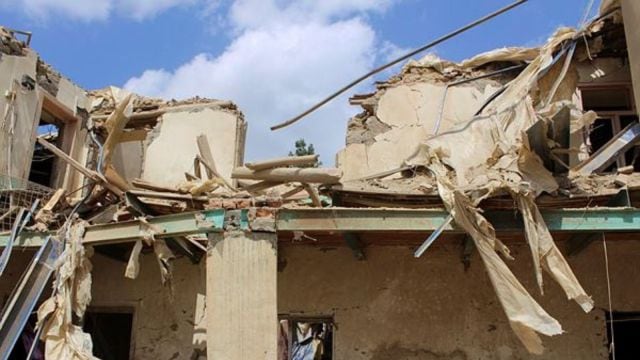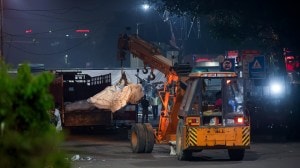Stay updated with the latest - Click here to follow us on Instagram
At least 800 dead, over 2,500 injured: All you need to know about Afghanistan earthquake
Rescue operations remain severely hampered by landslides, flooding and blocked roads in the mountainous Kunar region.
 A building destroyed in what Taliban authorities said was a Pakistani deadly drone attack is seen in Spera district of Khost province, Afghanistan. (AP)
A building destroyed in what Taliban authorities said was a Pakistani deadly drone attack is seen in Spera district of Khost province, Afghanistan. (AP)A 6.0-magnitude earthquake struck eastern Afghanistan overnight, leaving 800 dead and over 2,500 injured, Taliban officials confirmed on Monday.
Rescue operations remain severely hampered by landslides, flooding and blocked roads in the mountainous Kunar region affected by the quake, which also sent strong aftershocks as far as the capital, Kabul.
Officials warned that the death toll is likely to rise sharply as search and rescue operations continue.
Here is all you need to know about the earthquake:
- 01
Rising toll
Taliban spokesperson Zabihullah Mujahid said the death toll had crossed 800 by Monday afternoon, with hundreds more feared trapped under debris.
As per reports, relief operations faced major setbacks as access routes to the quake-hit areas were either destroyed or buried under debris, while the region’s rugged and steep terrain made movement even more difficult. “The number of casualties and injuries is high, but since the area is difficult to access, our teams are still on site,” health ministry spokesperson Sharafat Zaman said in a statement, according to Reuters news agency.
Officials warned that the toll was likely to climb as rescuers reach the hardest-hit areas.
- 02
Epicentre of the quake
The 6.0-magnitude earthquake hit Afghanistan’s mountainous eastern region on Sunday, hiting four provinces — Nangarhar, Nuristan, Laghman and Kunar — in eastern Afghanistan, with Kunar province worst affected.
According to the United States Geological Survey (USGS), the earthquake struck shortly before midnight, about 27 kilometres (16.7 miles) north-east of Jalalabad in Nangarhar province, at a relatively shallow depth of 8 kilometres (5 miles).
 The Afghan public health ministry said casualty figures remain uncertain due to poor mobile coverage in the affected areas. (Photo: @NilofarAyoubi/ X)
The Afghan public health ministry said casualty figures remain uncertain due to poor mobile coverage in the affected areas. (Photo: @NilofarAyoubi/ X)Tremors were felt more than 100 miles away in Kabul, and even in Pakistan’s Khyber Pakhtunkhwa and Punjab provinces, as per the Pakistan Meteorological Department.
- 03
Shallow impact
The earthquake was shallow, taking place close to the Earth’s surface, making it more destructive. Several aftershocks were reported overnight and into Monday. The United States Geological Survey (USGS) reported at least five aftershocks in the region, the strongest registering a magnitude of 5.2 within hours of the initial quake.
According to the USGS, nearly half a million people likely experienced strong to very strong tremors, levels capable of causing significant damage to poorly constructed buildings.
- 04
Hospitals overwhelmed
Local hospitals, especially in Asadabad in Kunar, as per The Guardian, reported being inundated with casualties, calling the situation an “overwhelming crisis.”
Reuters footage showed quake victims being carried on stretchers from a helicopter at a military base in Jalalabad, while additional images depicted injured people receiving treatment on hospital beds in the city.
- 05
Relief efforts
Afghanistan’s defence ministry said it deployed 30 doctors along with truckloads of medical supplies to Kunar to support local hospitals, state-run Bakhtar news agency reported.
 Civil defense workers, locals, and army soldiers prepare to evacuate injured victims of an earthquake that killed hundreds and destroyed numerous villages in eastern Afghanistan, in Mazar Dara, Kunar province, Monday, Sept. 1, 2025. (AP Photo/Hedayat Shah)
Civil defense workers, locals, and army soldiers prepare to evacuate injured victims of an earthquake that killed hundreds and destroyed numerous villages in eastern Afghanistan, in Mazar Dara, Kunar province, Monday, Sept. 1, 2025. (AP Photo/Hedayat Shah)The Taliban urged aid agencies to assist rescue operations in areas cut off by landslides and flooding. As per The Guardian, Mullah Nooruddin Turabi, head of the state ministry for disaster management, also travelled to Kunar on Monday to oversee the response. The United Nations in Afghanistan said it was ‘deeply saddened by the devastating earthquake in the east that claimed hundreds of lives,’ adding that its teams are already on the ground delivering emergency aid.
- 06
Widespread destruction
Many homes in the Kunar region, built from mud and rock, collapsed entirely, with survivors describing “death in every home.”
The epicentre struck near Jalalabad, a busy trade hub close to the Pakistan border, where swathes of low-rise, informal concrete and brick buildings remain highly vulnerable to quakes.
- 07
India pledges support
Prime Minister Narendra Modi expressed deep sorrow over the loss of life in Afghanistan following a deadly earthquake and pledged India’s support for relief efforts.
On X, Modi wrote: ‘Deeply saddened by the loss of lives due to the earthquake in Afghanistan. Our thoughts and prayers are with the bereaved families in this difficult hour, and we wish a speedy recovery to the injured. India stands ready to provide all possible humanitarian aid and relief to those affected.’
External Affairs Minister S Jaishankar on Monday spoke with Afghanistan’s Foreign Minister Mawlawi Amir Khan Muttaqi and expressed condolences. Jaishankar said that India has delivered 1,000 family tents to Kabul, and 15 tonnes of food are being transported from the Indian mission in Kabul to Kunar province. Additional relief material will be sent from India starting Tuesday.
- 08
Disaster-prone nation
Afghanistan sits atop active geological faults, making earthquakes a frequent and deadly threat, especially for its densely populated towns and cities.
In October 2023, a series of powerful earthquakes struck Herat province, killing nearly 1,300 people and injuring around 1,700, according to the United Nations.
A 5.9-magnitude quake in southeastern Afghanistan in 2022 caused widespread devastation. The UN reported at least 1,300 deaths, while the Taliban government estimated more than 4,000 fatalities at the time.
The earthquake compounds Afghanistan’s overlapping crises. According to the United Nations, less than 30 per cent of the country’s humanitarian needs for 2025 are being met, with over half of its 42 million people requiring aid, The New York Times reported.
 Residents inspect the site of a building destroyed in what Taliban authorities said was a Pakistani deadly drone attack, in Spera district of Khost province, Afghanistan, Thursday, Aug. 28, 2025. (AP Photo/Saifullah Zahir)
Residents inspect the site of a building destroyed in what Taliban authorities said was a Pakistani deadly drone attack, in Spera district of Khost province, Afghanistan, Thursday, Aug. 28, 2025. (AP Photo/Saifullah Zahir)
Since the Taliban returned to power, international assistance has steadily declined. Under President Donald Trump, the United States, which supplied 45 per cent of Afghanistan’s aid last year, has suspended nearly all contributions, leading to the closure of hundreds of hospitals and health centres. Other European countries, including Britain, France and Sweden, have also cut back support.
At the same time, Afghanistan’s population has increased, with more than two million nationals returning, often forcibly, from Pakistan and Iran amid rising xenophobia and political pressure. More were expected to return in the coming days. The earthquake struck as many Afghans were en route from Pakistan ahead of a Monday deadline imposed by Islamabad requiring departures or risk of arrest and deportation, The New York Times added.


- 01
- 02
- 03
- 04
- 05


 The Afghan public health ministry said casualty figures remain uncertain due to poor mobile coverage in the affected areas. (Photo: @NilofarAyoubi/ X)
The Afghan public health ministry said casualty figures remain uncertain due to poor mobile coverage in the affected areas. (Photo: @NilofarAyoubi/ X) Civil defense workers, locals, and army soldiers prepare to evacuate injured victims of an earthquake that killed hundreds and destroyed numerous villages in eastern Afghanistan, in Mazar Dara, Kunar province, Monday, Sept. 1, 2025. (AP Photo/Hedayat Shah)
Civil defense workers, locals, and army soldiers prepare to evacuate injured victims of an earthquake that killed hundreds and destroyed numerous villages in eastern Afghanistan, in Mazar Dara, Kunar province, Monday, Sept. 1, 2025. (AP Photo/Hedayat Shah)


























